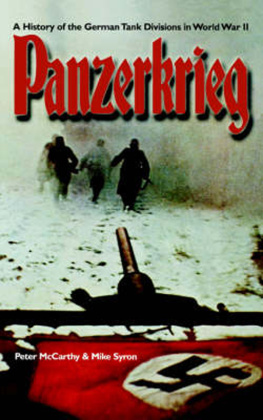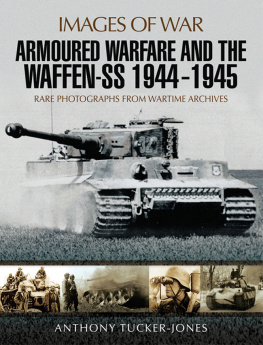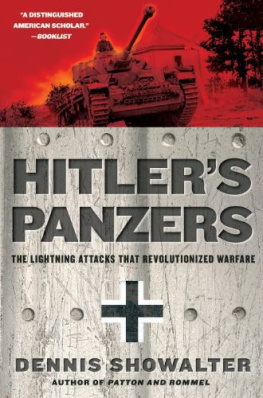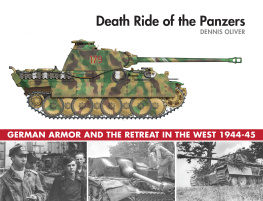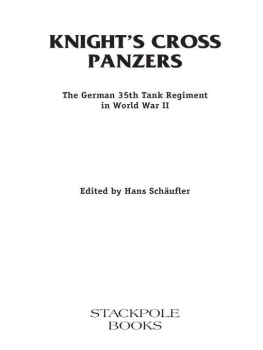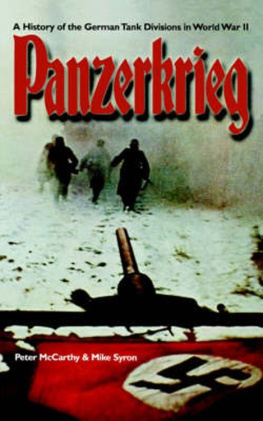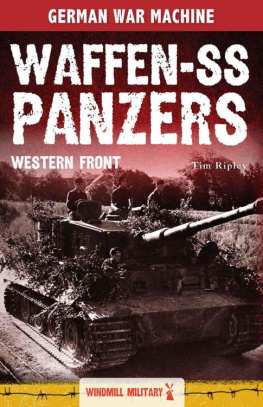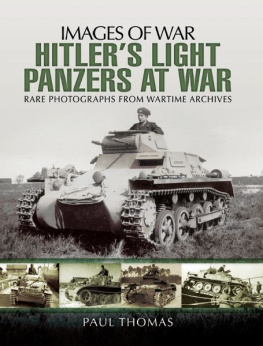MIKE SYRON, an archaeologist, and PETER MCCARTHY, a journalist, met while attending University College Dublin in the mid-nineties and soon discovered that they shared a fascination with the history of the Second World War, in particular that of the German armoured forces.
Panzerkrieg
A History of the German Tank Division in World War II
Peter McCarthy & Mike Syron
ROBINSON
London
Constable & Robinson Ltd
5556 Russell Square
London WC1B 4HP
www.constablerobinson.com
First published in the UK by Constable,
an imprint of Constable & Robinson Ltd 2002
This edition published by Robinson,
an imprint of Constable & Robinson Ltd 2003
Copyright Peter McCarthy and Mike Syron 2002
The right of Peter McCarthy and Mike Syron to be identified as the authors of this work has been asserted by them in accordance with the Copyright, Designs and Patents Act 1988
All rights reserved. This book is sold subject to the condition that it shall not, by way of trade or otherwise, be lent, re-sold, hired out or otherwise circulated in any form of binding or cover other than that in which it is published and without a similar condition including this condition being imposed on the subsequent purchaser.
A copy of the British Library Cataloguing in
Publication data is available from the British Library
ISBN1-84119-800-5 (pbk)
ISBN 1-84119-392-5 (hbk)
eISBN 978-1-47210-780-0
Printed and bound in the EU
10 9 8 7 6 5 4 3 2 1
For Avril, Scott and the memory of A.J.
Mike
To my family
Peter
Also to all the tankers of World War Two.
Panzerlied
(Tank Song)
I
Whether in storm or in snow
Whether the sun smiles on us
The day blazing hot
Or the night ice cold
Our faces are dusty
But our spirits are cheerful
Yes, our spirits are cheerful
Our tank roars
Into the windstorm.
II
With thundering engines
As fast as lightning
We engage the enemy
Safe in our tanks
Far ahead of our comrades
In battle we stand alone
Yes, stand alone
We strike deep
Into enemy territory.
III
If an enemy tank
Appears in our sight
We ram throttles full
And close with the foe!
We give our lives freely
For the army of our realm
Yes, the army of our realm
To die for Germany
Is our highest honour.
IV
With barriers and tanks
Our opponent tries to stop us
We laugh at his efforts
And travel around them.
And when guns threatingly
Hide in the yellow sand
Yes, in the yellow sand
We search for paths
No-one else has found.
V
And if some day
Faithless luck abandons us
And we cant return home
The deadly bullet strikes
And fate calls us,
Yes, fate calls us
Then our tank is
An honourable grave.
Written by Oberleutnant Wiehle in June 1933.
Contents
Illustrations
Between
Between
All photographs listed are used with the kind permission of The Trustees of The Imperial War Museum, London, unless otherwise stated.
Maps
Introduction
T HIS is the story of the Panzerwaffe, the German armoured divisions in the Second World War, the elite tank forces of the Wehrmacht. It is a dramatic story as befits a dramatic war, recounting great victories and crushing defeats, in battlefields ranging from the bocage country of France and the endless steppes of Russia to the deserts of North Africa.
At almost every decisive moment of the war, the panzers can be found. They were the instrument used to achieve the Anschluss in 1938 and to occupy Czechoslovakia a year later. When the Wehrmacht rumbled across the Polish frontier in September 1939, igniting the Second World War, it was the mobility and speed of the panzers that so captured the imagination of the world and created the myth of whole armies of tanks.
William L. Shirer, that self-appointed expert on all aspects of the Third Reich vividly, if somewhat inaccurately, described this new method of waging war:
the sudden surprise attack; the fighter planes and bombers roaring overhead, reconnoitring, attacking, spreading flame and terror; the Stukas screaming as they dove; the tanks, whole divisions of them, breaking through and thrusting forward thirty or forty miles in a day; self-propelled, rapid-firing heavy guns rolling forty miles an hour down even the rutted Polish roads; the incredible speed of even the infantry, of the whole vast army of a million and a half men on motorised wheels, directed and co-ordinated through a maze of electronic communications
Had his book, The Rise and Fall of the Third Reich, only been as well researched as it was widely read, then perhaps the above popular misconception about the German war machine might never have got such firm hold. It is ironic that a man who took great pride in sorting the Nazi propaganda ministrys wheat from the chaff should succumb so readily to the carefully crafted newsreels supplied by Goebbels. Of the fifty or so German divisions which invaded Poland, only six were panzer divisions and the vast majority of the 1.5 million-strong army travelled on foot, with no better mobility than Napoleons armies.
In fact at that time, the Panzerwaffe, the newest German arm, was still little more than an exercise unit for flag-trooping, sabre-rattling and parade ground displays. Their tanks were small, cheap and, in keeping with Hitlers megalomania, numerous, but of little practical value on the battlefield. Within a year however the Panzerwaffe would truly come of age, evolving into something greater than even its progenitors dared hope for, even if it never quite became the monstrous, mechanised juggernaut its opponents claimed it was.
In May 1940 came the panzers greatest victory. Seven panzer divisions slashed their way through the Ardennes (terrain the Allies declared impassable for tanks) and raced for the English Channel. By so doing they trapped a million Allied soldiers, forcing the British to evacuate at Dunkirk and the French to surrender. It remains one of the most startling victories in modern warfare; the largest army in Europe, with tanks superior to the Germans both in number and quality, was defeated in weeks by a new method of war: Blitzkrieg.
The unstoppable panzers became a convenient alibi for the Allies in defeat, yet what the Germans had done with their tanks was in fact not so radical or unexpected; it had been theorised about for the past twenty years, mainly by Englishmen. All they had done in reality was to take a twenty-year-old weapon, largely unproven in battle and downgraded between the wars to a mere infantry support weapon, and used it to its full potential. While other nations theorised and debated about the merits of the tank, the Germans acted, successfully turning the weapon against its own inventors.
A year later the panzers were taking on Russia, pitting themselves against the 20,000 tanks of the Red Army they came within a hairs breadth of victory, halted at the gates of Moscow by winter and Siberian reinforcements. In 1942, they were again close to success when the Stalingrad disaster changed everything. In that same year in North Africa, the panzers were just miles from Alexandria when defeated at El Alamein by vastly superior forces.
From 1943 on, the Panzerwaffe was largely on the backfoot, fighting defensively to slow down the inexorable Allied advance and make them pay a high price for every yard gained. In this enforced role they pioneered new ways of fighting and new weapons which proved highly effective. In 1944, the Battle of the Bulge became their offensive swansong in the West, just as Kursk had the previous year in the East, yet they were still able to seize local victories from the jaws of defeat. Small numbers of German tanks often inflicted heavy losses when the Allies got careless, such as at Villers Bocage in June 1944.
Next page
